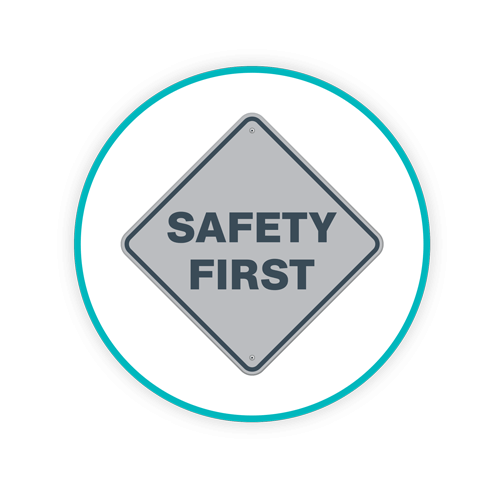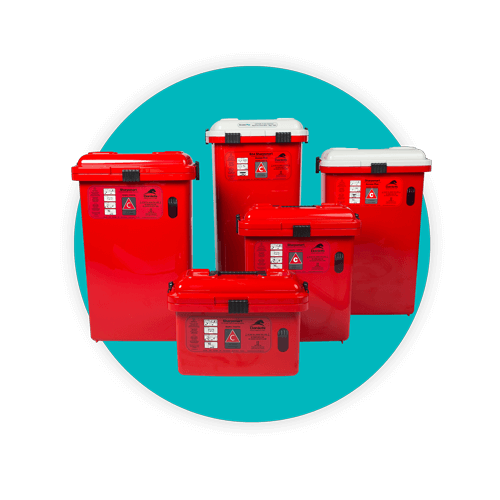How Do You Dispose of Cytotoxic Waste?

Cytotoxic waste disposal in Canada can be a complex issue. You’re probably already aware of how vital it is to properly identify cytotoxic waste to ensure its safe handling and disposal in your Canadian province. But your facility must also make certain that all employees understand how to label, pack, and dispose of any potentially toxic waste as well.
During each step of the handling process there are risks which need to be mitigated against, from healthcare workers disposing of such waste to transportation to finally the waste facility which receives the material. At each step, precautions must be taken to protect workers, the public, and the environment. Here we’ll examine some of the best practices Canadian healthcare providers should take when dealing with cytotoxic waste.
TOPICS WE WILL COVER:
2 / Dangers of cytotoxic waste
4 / Guidelines for handling cytotoxic waste
4 / Disposal of cytotoxic waste
5 / Safe cytotoxic waste disposal
What is cytotoxic waste?
Cytotoxic waste is a type of waste that contains cytotoxins. So then the next obvious questions are “What are cytotoxins?” and “What is cytotoxic?” Cytotoxins are substances that can damage or kill cells. When waste can have a toxic effect on cells, it is cytotoxic. Cytotoxic waste typically consists of materials that have come in contact with cytotoxic drugs, or antineoplastic drugs, as they are also called. This is commonly referred to as chemotherapeutic waste, however cytotoxic waste is a broader term that includes other types of substances as well.
Common examples of healthcare cytotoxic waste include syringes, gloves, needles, air filters, vials, clothing, diapers, and dressings, among other items. These items can pose both a biohazard risk and also a chemical hazard as well because of the substances used in such treatments.
The cytotoxic drugs that these materials are exposed to are toxic to cells and used to treat diseases such as cancer, rheumatoid arthritis, and multiple sclerosis. Cytotoxic drugs are intended to kill the abnormal cells causing these diseases. Unfortunately, these drugs kill healthy cells as well as unhealthy cells. So, they require careful handling and disposal.
It is also important to remember that any waste that is mixed with or comes into contact with cytotoxic waste is considered hazardous waste. So, this waste must then be disposed of just as carefully as the cytotoxic waste.
Cytotoxic drugs and waste are dangerous to workers who may be exposed to them and these substances also pose a threat to the environment as well. So, there are a number of regulatory agencies in charge of ensuring that the facilities using cytotoxic drugs properly dispose of this type of waste. There are also federal departments that have made acts regulating these substances to limit the risk they pose to people and the environment.
Dangers of cytotoxic waste 
Workers can be exposed to cytotoxic waste through ingestion, inhalation, percutaneous injury, or through skin absorption. It is unknown what the specific long-term effects of exposure to cytotoxic drugs or waste are. However, enough about these drugs is known to indicate that they could cause a number of health problems. Some of the health risks associated with these substances include:
- Liver damage
- Miscarriage
- Leukaemia
- Infertility
- Abdominal pain
- Skin rashes
- Hair loss
- Nasal sores
- Necrosis to exposed tissues
- Mutation of cells
Exposure to these drugs or their waste can cause these effects in patients or anyone exposed to the drugs or waste.
Handling cytotoxic waste
Cytotoxic waste needs to be handled carefully to ensure the safety of not only the workers involved in directly treating patients but also support staff in these healthcare facilities and those disposing of the waste. Although nurses and pharmacy workers are often those who run the greatest risk for exposure to cytotoxic waste, in order to protect all employees and patients, facilities must take care to carefully package, store, and dispose of cytotoxic waste so that no one is exposed. All waste generators are responsible for keeping their workers, the public, and the environment safe from this waste.
The most likely way for healthcare workers to be exposed to cytotoxic waste is by touching a body fluid, contaminated object, or contaminated surface. Another common means of exposure is through a needle stick injury during the administration of such therapies or during disposal. It is essential for all staff to be cognizant of the fact that the bodily fluids or waste of patients being treated with cytotoxic drugs might also be contaminated with cytotoxic waste and thus pose a similar threat to the drugs themselves.
Antineoplastic agents are classified according to the possible dangers they present for negative health outcomes. These classifications are carcinogenic to humans, probably carcinogenic to humans, and possibly carcinogenic to humans. The most common cytotoxic medications currently used to treat patients are Arsenic Trioxide, Thiotepa, Busulfan, Etoposide, and Tamoxifen.

Guidelines for Handling Cytotoxic Waste
The rules for cytotoxic waste vary depending on the province in which your facility is located. There are also manufacturers’ guidelines which should be adhered to. Here are some general guidelines for dealing with cytotoxic waste:
- All facilities that use cytotoxic drugs should train their workers about the dangers of these drugs as well as how to dispose of them.
- Personnel should use personal protective equipment when handling cytotoxic waste. This includes a gown, head cover, mask, goggles, gloves, and appropriate footwear.
- All cytotoxic waste must be stored in an area that is contained and isolated, with proper ventilation, preferably negative air pressure, in order to limit drug residue in the air.
- Handlers of cytotoxic drugs should make sure they are aware of the half-life of the drugs to ensure safer disposal. The half-life for these substances can vary considerably. For example, busulfan has a half-life of 2.5 hours, whereas tamoxifen has a half-life of up to 11 days.
Disposal of Cytotoxic Waste
Cytotoxic waste should always be segregated from other waste streams. Additionally, as with the guidelines for handling cytotoxic waste, different provinces may have different guidelines for disposing of these substances. There are also manufacturers’ and distributors’ recommendations to consider.
If you are unsure how this waste should be disposed of, look for information provided by pharmaceutical professionals as well as specific information on disposal from your local, municipal, or provincial government.
Here are some basic guidelines for disposing of cytotoxic waste:
- The Canadian Union of Public Employees recommends that when cytotoxic drugs are disposed of, they be in plastic bags that are a minimum of 2 mm thick for polypropylene bags and for contaminated material, 4mm thick. The bags should also be colour-coded and labelled with a cytotoxic warning label.
- Cytotoxic and antineoplastic drugs and waste are required to be segregated and identified. They must be correctly identified by labels or placards that have a red triangle on a grey background with a white “C” in the middle, the cytotoxic symbol. Beneath this symbol, the words Cytotoxic/Cytotoxic in capital letters must be located. Additionally, The Ministry of Environment mandates the use of bilingual wording.
- Cytotoxic substances should be put in rigid, leak-proof containers that you have identified with a cytotoxic toxic hazard symbol. Containers are to be rigid, red-coloured, and leak-proof CSA Standard Z31 6.6-7.

Rely on Safe Cytotoxic Waste Disposal from an Industry Leader
Daniels Health Canada can help your facility safely dispose of cytotoxic waste by providing education and training to your staff involved in its disposal. We have many resources and products for healthcare providers that make it easier to protect themselves and the environment.
If your organization is looking for a more seamless and worry-free approach to cytotoxic waste, turn to our expert team who can help create the right disposal program that is appropriate for your needs, covering everything from safe handling and disposal to cytotoxic waste removal and disposal.
Let's Talk!
Your time is valuable, and we don’t want to play hard to get. You can either phone us directly on the details listed on our contact page, or feel free to fill out this short form and one of our team members will get back to you as quickly as possible.
